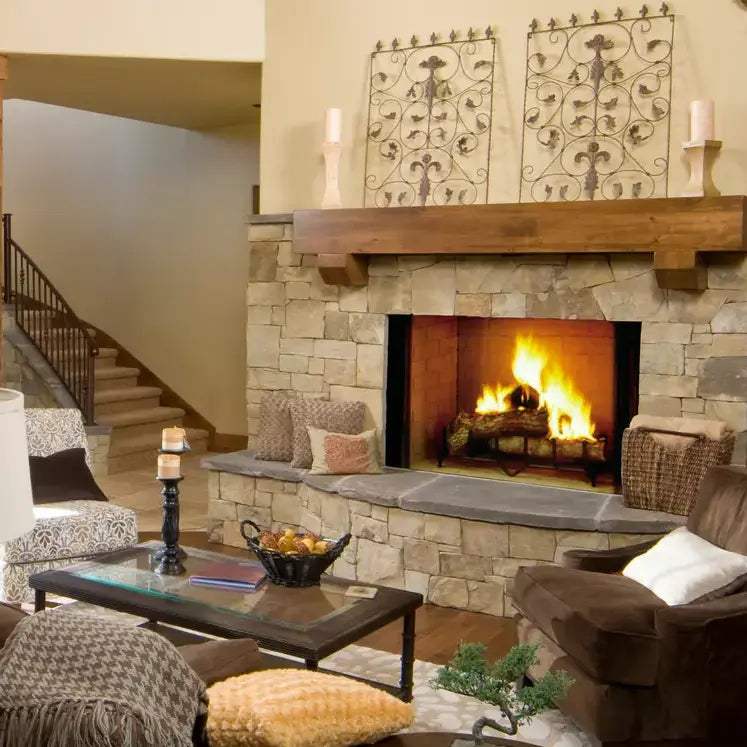Deciding to invest in a modern fireplace is an exciting decision, one that improves both your home’s aesthetics and how it feels when those chilly nights start to creep in. There’s just one question - is a gas or wood fireplace better for YOUR home? You’ve come to the right place.
Our wood vs gas fireplace comparison will weigh both sides to help you see the pros and cons each style has to offer - and in turn, which is a better fit for your space. Here’s the quick answer:
| Gas Fireplace Recommended | Wood Fireplace | |
|---|---|---|
| Emissions & Air Quality | Very low particulate emissions (especially direct-vent). No smoke indoors; easier to meet urban/ HOA rules. | Higher particulate matter and smoke; may face burn bans or stricter local regulations. |
| Ease & Maintenance | Push-button start, precise flame/heat control, minimal cleanup; annual check recommended. | Routine ash removal, chimney sweeping, and wood handling/ storage required. |
| Installation & Venting | Flexible options (natural gas/propane; direct-vent or vent-free where allowed). Good for remodels. | Requires chimney/ flue; clearances and hearth protection add complexity and cost. |
| Heat Delivery | Consistent, controllable BTU output; thermostats and blowers available for steady comfort. | Strong radiant heat near the fire; output varies with fuel quality and tending. |
| Operating Costs | Predictable fuel cost via utility or propane; low time/ labor cost; no wood handling. | Can be inexpensive if you source wood yourself; higher time/ labor cost; storage space needed. |
| Reliability & Power Outages | Many models operate without household power (millivolt/ battery ignition), though fans need electricity. | Works off-grid; no utility required — a plus for remote locations. |
| Ambiance | Real flame with clean glass view; wide design range (linear, see-through, traditional). | Classic crackle, aroma, and ritual that some homeowners prefer. |
| Environmental Angle | Lower on-site emissions and no ash; simple to keep clean and efficient day-to-day. | Renewable fuel when sustainably harvested, but higher smoke/ PM output and ash handling. |
| Best For | Eco-minded, convenience-first homeowners; urban/ suburban installs; modern, low-maintenance living. | Rural or off-grid settings; those who enjoy the hands-on wood-burning experience. |
|
Quick Take: If your priority is keeping Earth cooler while staying warm, gas generally wins on everyday emissions and ease. Wood offers tradition and off-grid independence. Either way, weigh comfort alongside environmental impact — and choose the path that fits your home and habits. Shop Gas Fireplaces |
||
The Great Fire Company is your trusted choice for a built-in fireplace online. Whether you end up leaning towards a wood or gas fireplace, we stock the best brands in the industry and back them up with free shipping, low price guarantee, and world-class customer service from A to Z.
Gas Fireplaces: A Fit for Every Space
Gone are the days when installing a fireplace meant preparing for a major renovation project. Gas fireplaces have changed the game with their versatility. Whether you live in a spacious house or a cozy apartment doesn't matter; there's likely a gas fireplace solution that works for your space.
- Apartments and condos can now enjoy the glow of a fireplace without worrying about traditional chimney requirements thanks to vent-free models.
- Different types of gas logs let you customize your flame's look from modern chic to rustic charm without chopping any wood.
- Vent configurations range from direct vents going through walls to more straightforward vent-free options, making installation easier than ever before.
Choosing between different styles and fuel types means considering what fits best with your lifestyle as much as with your decor preferences. Let’s look at the other half of our wood vs gas fireplace comparison below.
Wood-Burning Fireplaces: Traditional Charm That Requires Space and Effort
If you're leaning towards traditional wood-burning fireplaces, remember they bring ambiance but also need proper planning around ventilation and storage. They suit larger spaces where storing wood isn’t an issue—think detached houses rather than urban lofts.
- The crackling sounds and real flames offer unmatched coziness but remember; this option needs regular chimney cleaning and ash disposal – not exactly low maintenance.
- The charm is undeniable but make sure you’re up for keeping up with those burning logs.
In short? Your living environment might lean heavily on which type suits better—gas offers flexibility while wood brings traditionality into play. But hey. Both ensure those cold nights feel nothing short of magical at home. So, is a gas or wood fireplace better?
Wood-Burning Fireplace vs Gas Fireplace: Key Differences to Consider

Only you can decide which best suits your home between a wood vs gas fireplace - but we can help you narrow it down based on the factors that matter most! Here are the things you need to consider in comparing a wood-burning fireplace vs gas fireplace…
The Efficiency Battle
Efficiency ratings tell you how well fireplaces turn fuel into heat without letting any go to waste. Think of them as the MPG (miles per gallon) for your car but for your fireplace.
A gas fireplace's efficiency rating might look pretty awesome, sitting at around 70-99%. On the flip side, wood-burning fireplaces lag behind with ratings between 10-30%. What gives? Well, gas units are designed to keep more heat in while sending less up the chimney.
Sure, cozying up by a crackling wood fire is great until you see your heating bill. Why? That lower efficiency means more heat escapes—and that's like throwing money out with the smoke.
A natural gas fireplace has the edge here, burning fuel so efficiently that little gets wasted. Burning wood is sort of like burning cash. This is an obvious advantage for the wood vs gas fireplace.
Environmental Considerations
The environment might not be the first thing on your mind as you cozy up next to a fireplace - but it definitely deserves some attention in choosing between a wood-burning fireplace vs gas fireplace.
Wood produces more particulate matter and emissions than its gas counterpart. They taint the air we breathe to some extent, possibly sparking health hazards for folks around. We're talking respiratory issues, allergies – not fun stuff.
Natural gas fireplaces are a cleaner alternative when it comes to pollutants released into our atmosphere. Gas units emit far less smoke and harmful byproducts compared to wood burners which makes them a better pick for indoor air quality.
Now, you do need to consider the fact that gas is a fossil fuel source contributing its share towards greenhouse gases once burned. Though lower in emissions than wood fires or even coal heating methods, they don’t quite reach zero marks on environmental impact charts either.
Still, we think gas fireplaces have a slight edge here over their wood-burning counterparts.
Convenience
Gone are the days of laboring to start a fire. Gas fireplaces have changed the game, offering a flick-of-the-switch convenience that wood-burning counterparts can't match. Just imagine sitting back, remote in hand, and igniting flames without moving an inch—sounds like a dream, right?
But let's not forget our old friend, the wood fireplace. The act of assembling logs and breathing life into a fire, despite the effort required, carries an unmistakable allure. It’s not always what you want to deal with, though. Gas has the advantage in convenience as well.
Cost Analysis
We talked about cost of operation, but which is more affordable upfront, a wood vs gas fireplace?
The initial setup cost of a natural gas or propane fireplace might range from $1,300 to over $10,000, but they’re usually cheaper in operation than their wood-burning cousins, so they pay for themselves in the long run.
Wood fireplaces, on the other hand, will actually be even more expensive all-in if you don’t already have a chimney in your house. This is quite the project to undertake, and the fireplace itself can cost anywhere between $3,500 to $8,000+!
Design Flexibility and Installation Options
You should also think about the wood vs gas fireplace in terms of design and installation options. It’s got to fit your home, after all!
Gone are the days when installing a fireplace meant preparing for a major renovation project. Gas fireplaces have changed the game with their versatility. Whether you live in a spacious house or a cozy apartment doesn't matter; there's likely a gas fireplace solution that works for your space.
On the other hand, wood-burning fireplaces bring plenty of ambiance but also need proper planning around ventilation and storage. We just talked about the chimney element. They suit larger spaces where storing wood isn’t an issue—think detached houses rather than urban lofts.
Maintenance Demands
Gas units definitely need less elbow grease – no ash clearing or chimney sweeping required. Just occasional check-ups to make sure they’re running efficiently without leaking anything sneaky like carbon monoxide.
The lumberjack lifestyle has quite a few chores though—storing wood can feel like prepping for winter all year round. Plus, regular chimney cleanings are non-negotiable unless you fancy a surprise visit from your local firefighters because nobody wants those kinds of sparks flying around.
In thinking about this aspect of the wood vs gas fireplace debate, it’s clear one is better than the other. But is a gas or wood fireplace better overall?
So, is a Gas or Wood Fireplace Better?
As you can probably see from this thorough comparison of the wood-burning fireplace vs gas fireplace, gas makes more sense for the vast majority of homeowners.
These deliver real flames without the smoke, ash, or ongoing labor that comes with burning wood. With push-button ignition, adjustable heat, and consistent BTU output, gas fireplaces offer both comfort and convenience. They also produce fewer emissions than wood-burning units, so they’re cleaner for the environment as well!
At The Great Fire Company, you’ll gain access to the most comprehensive selection of gas fireplaces online from brands like Napoleon, Majestic, Empire, and Superior.
From the ventless gas fireplace style to the direct vent fireplace, the built-in gas fireplace, the linear gas fireplace, and more - we’ve got something for every need in our lineup, always sourced from the best brands in the industry at unbeatable prices.
With world-class customer service along the way, what more could you ask for? Shop now or get in touch for a personalized recommendation.
Wrapping Up Our Wood vs Gas Fireplace Comparison
That concludes our wood vs gas fireplace comparison. We've walked through efficiency ratings, style, costs (upfront and ongoing), sustainability, and of course, convenience. Gas has the undeniable edge in just about every way.
Whether you’re building a fireplace from scratch or just want the best gas fireplace inserts, your search ends here at The Great Fire Company. Take the next step today and browse our collection!


